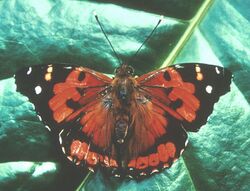Biology:Ditrysia
| Ditrysia | |
|---|---|

| |
| Kamehameha | |
| Scientific classification | |
| Domain: | Eukaryota |
| Kingdom: | Animalia |
| Phylum: | Arthropoda |
| Class: | Insecta |
| Order: | Lepidoptera |
| Clade: | Myoglossata |
| Clade: | Neolepidoptera |
| Infraorder: | Heteroneura |
| Clade: | Eulepidoptera |
| Clade: | Ditrysia Borner, 1925 |
| Principal clades and superfamilies[citation needed] | |
The Ditrysia are a natural group or clade of insects in the lepidopteran order containing both butterflies and moths. They are so named because the female has two distinct sexual openings: one for mating, and the other for laying eggs (in contrast to the Monotrysia).
About 98% of described species of Lepidoptera belong to Ditrysia. As larvae, they initially feed on plants until they grow to become adults and feed on nectar. They function as herbivores, pollinators, and prey in terrestrial ecosystems, while also being extremely damaging to the development of agriculture.[1] The Lepidoptera group can be divided into the primitive but paraphyletic "micromoths" and the derived monophyletic Apoditrysia, which include mostly larger moths, as well as the butterflies. Those with a dorsal heart vessel belong in section Cossina.[2] Others, having a ventral heart vessel, belong in section Tineina.[3] While it is difficult to pinpoint the origin of affinities between clades, Tineoidea are found to be useful in understanding the vast diversity in Ditrysia. Obstecomera and Macrolepidoptera are other examples of Ditrysia's subclades.[further explanation needed] Apoditrysia, Obtectomera, and Macrolepidoptera will be considered monophyletic if one or more organisms are either included or excluded from the clade.[4]
See also
- Lepidoptera
- Taxonomy of Lepidoptera
References
- ↑ Regier, Jerome C.; Zwick, Andreas; Cummings, Michael P.; Kawahara, Akito Y.; Cho, Soowon; Weller, Susan; Roe, Amanda; Baixeras, Joaquin et al. (2009-12-02). "Toward reconstructing the evolution of advanced moths and butterflies (Lepidoptera: Ditrysia): an initial molecular study". BMC Evolutionary Biology 9 (1): 280. doi:10.1186/1471-2148-9-280. ISSN 1471-2148. PMID 19954545. Bibcode: 2009BMCEE...9..280R.
- ↑ Encyclopedia of Entomology (2nd ed.). New York: Springer Verlag. 2008. p. 657. ISBN 9781402062421. https://books.google.com/books?id=i9ITMiiohVQC&q=Ditrysia.
- ↑ "Tineina - Wiktionary". https://en.m.wiktionary.org/wiki/Tineina.
- ↑ "Comprehensive gene and taxon coverage elucidates radiation patterns in moths and butterflies". Proceedings. Biological Sciences 277 (1695): 2839–48. September 2010. doi:10.1098/rspb.2010.0392. PMID 20444718.
Further reading
- "Phylogeny and paleontology". Lepidoptera: Moths and Butterflies. 1. Evolution, Systematics, and Biogeography.. Handbook of Zoology. IV. Berlin and New York: De Gruyter. 1999. pp. 7–25.
- "A molecular phylogeny and revised classification for the oldest ditrysian moth lineages (L epidoptera: T ineoidea), with implications for ancestral feeding habits of the mega‐diverse D itrysia.". Systematic Entomology 40 (2): 409–32. April 2015. doi:10.1111/syen.12110.
External links
Wikidata ☰ Q843246 entry
 |
